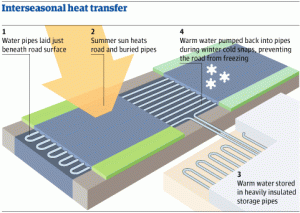Pams second post on snow and ice clearance over at Public Works blog, reminded me of two items I had collected into my google notebook for future isite posts.
 Reported in the Guardian Friday last Under Road heaters may beat snow and ice , the Highways Agency plans to install pipes underneath a section of road to gather solar energy in summer and recirculate it in winter. Experts hope the scheme could be a way to treat the roads which are the first to freeze.
Reported in the Guardian Friday last Under Road heaters may beat snow and ice , the Highways Agency plans to install pipes underneath a section of road to gather solar energy in summer and recirculate it in winter. Experts hope the scheme could be a way to treat the roads which are the first to freeze.
The scheme, known as interseasonal heat transfer, or IHT, will lay a network of plastic pipes filled with water just below the road surface. In summer, when road temperatures can reach 40C, the water is warmed and pumped to pipes insulated with polystyrene. In winter, when sensors detect the temperature at 2C, warm water is pumped back under the road to heat the ground and prevent ice forming.
Also a Guardian mp3 audio item to download Which discusses the technology and approach to using IHT on UK roads.
Too cool for schools – featuring a pièce de résistance of the building as the construction of the world’s first IHT system underneath the playground. IHT will take heat from the sunshine that falls on the tarmac playground, then stores it and releases it in the winter to heat the school.
If you like this please share:

